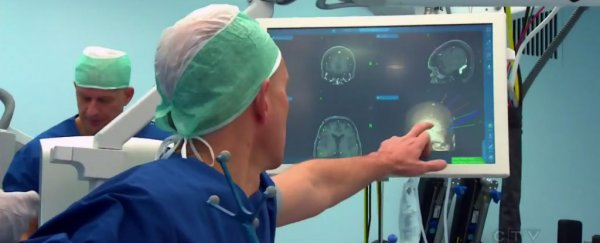A paralysed woman in the Netherlands is the first to be fitted with a new type of brain implant that allows patients who cannot speak or move to communicate using nothing but their thoughts.
The new implant, which works with a computer interface to help her spell out words and sentences, can be used anywhere, allowing her to communicate with people in the outside world, without medical experts on hand to help.
"This is a world first," neuroscientist and lead researcher Nick Ramsay, from the University Medical School Utrecht, told CNN. "It's a fully implantable system that works at home without need for any experts to make it work."
Hanneke de Bruijne was diagnosed with amyotrophic lateral sclerosis (ALS) in 2008, and soon her nerve cells completely gave way.
In the space of just two years, she went from healthy to incapable of breathing without a ventilator, and she could no longer move or speak.
Before Ramsey met de Bruijne, she communicated using a system that tracked her eye movements, allowing her to select certain words and letters on a computer screen to form sentences.
But even this might have been a temporary measure. As Jessica Hamzelou reports for New Scientist, one in three people with ALS eventually lose the ability to move even their eyes.
Ramsay wanted to figure out how to build a system that didn't rely on any kind of physical movement at all (the system Stephen Hawking famously uses relies on the patient having control over their cheek muscles).
This meant one thing - a mind-reading device.
We've seen a lot of different brain implant devices cropping up for people with paralysis or lost limbs over the past couple of years, but as can be expected when the technology is so new, it's been a slow process to get them out of the lab and into people's homes.
Ramsay and his team wanted to build something that could be operated by a patient at home, and without constant supervision by a medical expert.
"Somehow, they never really break through into clinical application," he told Meera Senthilingam at CNN. "Nobody made the step to make it work at home."
The device is surgically implanted into the brain, with two electrodes placed over the motor cortex region of the brain, which controls movement.
The exact placement of these electrodes is crucial - one has to be positioned over the part of the brain responsible for moving the right hand, and the other is placed over the part of the brain that kicks into gear when you want to count backwards.
These electrodes are connected to a pacemaker-sized transmitter implanted into de Bruijne's chest, and this transmitter is able to wirelessly communicate with a computer program displayed on a screen in front of her.
When de Bruijne watches the screen, she'll see a square moving over letters. Once the square has landed on a letter she wants to use, she must imagine moving her right hand to click on the letter.
Of course, she can't move her right hand, but her brain still produces the same signal that it would if she could, and the electrodes pass this signal on to the transmitter, to be passed on to the computer program.
After just six months of training, de Bruijne can use the system with 95 percent accuracy.
"Using the device to communicate is still a slow process - it can take a few minutes to spell a single word - but [de Bruijne] is getting faster with training," Hamzelou reports for New Scientist.
"At first, it took her 50 seconds to select a letter - she can now do it in 20 seconds."
While some have raised concerns about subjecting patients to surgery to implant the device, de Bruijne says she feels far more confident communicating outside and in public, and particularly in places where the natural light made the eye-tracking device malfunction.
"Now I can communicate outdoors when my eye-track computer doesn't work," she told Hamzelou. "I'm more confident and independent now outside."
Of course, the system has so far only been tested on one patient, so while it's a big deal that the team has managed to move it from a clinical setting to de Bruijne's home, the next patient might not see so much success, so we have to remain cautiously optimistic for now.
But Ramsay's next goal is to speed things up for de Bruijne by adding more electrodes. He envisions having systems of 30 or 60 electrodes that could be used to decode sign language or internal speech far quicker than the current system.
"Then you could spell the way a deaf person would spell," he told CNN. That's the goal."
The case study has been published in the New England Journal of Medicine.
